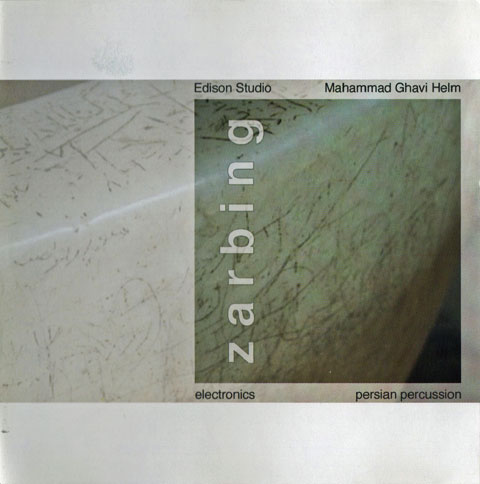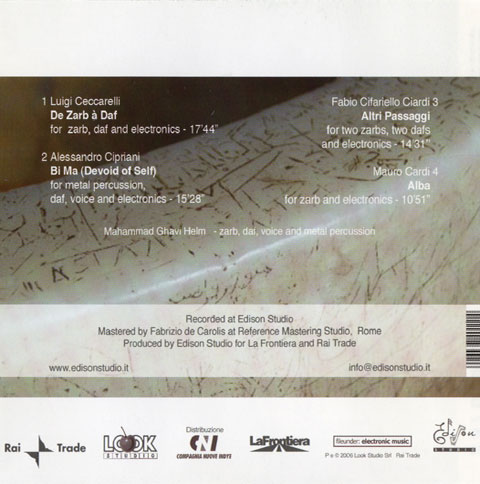La Frontiera LFDL 18401 – RaiTrade RTP00902005
contains:
Luigi Ceccarelli – De Zarb à Daf
Alessandro Cipriani – Bi Ma (Devoid of Self)
Fabio Cifariello Ciardi – Altri Passaggi
Mauro Cardi – Alba
Mahammad Ghavi-Helm, zarb, daf, voices and metallic percussions
produced by Edison Studio for La Frontiera and RAI Trade


reviews
Edison Studio / Mahamad Ghavi Helm
ZARBING (Raitrade/Cni)
A virtuoso of the zarb and the daf, two different drums of ancient Persia, as well as a vocalist, Mahammad Ghavi Helm is an Iranian who now resides in France. A master of a musical tradition that began many millennia ago, as well as an expert in contemporary music, he now has met and joined forces with Luigi Ceccarelli, Alessandro Cipriani, Fabio Cifariello Ciardi and Mauro Cardi the four Italian composers of Edison Studio. All of the latter are very active in the production of music based on artificial sounds, and they have successfully gambled on the integration of electronic technology and ancestral percussion acoustic instruments. In the piece De zarb à zaf Ceccarelli is tribal and secular, while in Bi ma Cipriani is evocative and mysterious, in Altri passaggi Cifariello Ciardi is magnificently complex, suspended between technological euphoria and a “Journey to the Center of the Earth”, and finally in Alba Cardi is engrossed in refined sounds and original sequences.
Mario Gamba – Alias 37, il Manifesto 23/09/2006
From the trunk of a walnut tree comes the magical zarb drum
Mahammad Ghavi Helm is a master of Iranian percussion, who has been active in France for many years. Thanks to him and another great virtuoso, Ostad Hosein Therani, the zarb, an archaic drum fashioned from a walnut trunk and covered with goatskin, has once again become a living and breathing instrument. In fact musical instruments never really die, but they acquire new life when, even though ancient, they are invested with the creative intentions of new composers. This is what the four Italian musicians Cardi, Ceccarelli, Cipriani and Cifariello Ciardi have done, after a long period of courtship. They have combined the sounds of other traditional Persian drums with the zarb, in addition to live-electronics, thereby opening up new possibilities of manipulating our perception of sound, in time, in space, and in the “grain of the voice”. Mahammad Ghavi does not only play these evocative percussion instruments beautifully,
but on three of the tracks he sings some verses by Jalal ad-Din Rumi, the twelfth century Persian poet and mystic, who is seen as the founding father of Sufism. There could hardly be a more global record, more varied and diverse as regards the origin of its components, or more exposed to the risks of the superficial lingua franca or koinè of the expanded and homogenized globalisation that is so prominent in contemporary popular music. Here, instead, each musician always remains himself. Ceccarelli confirms the quality of his rhythmic sense: for him music is dance, movement and gesture, and he wisely follows the fingers and the inspiration of the soloist to whom he has entrusted his composition. Cipriani prefers to distort the voice, annihilating it at first and then releasing it, like a fire that crackles and then takes flight in the final invocation, when Rumi declares that he is “free from obedience and from corruption, free from the ego”. Cifariello Ciardi concentrates on – and narcissistically falls madly in love with – the fascinating charm of the drum skins and their crackling,
whistling and whispering, so profoundly resonant, also with our typically Western anxieties that are hardly consoled by Sufism. Marius Schneider, the scholar who sought the relationship between sound and animal life, defined the drum as “the mother of all things, a bridge between heaven and earth”, suspended between an evocation without weight and the frenetic and sensual physicality that it is able to create. Alba, the piece composed by Mauro Cardi, insists on these boundaries. This track is elusive and persistent, like a labyrinth of the psyche, while the voice, the drum and the electronic echoes seem to be seeking and questing in accordance with the poet’s words: “Oh you, zephyr of spring, why have you gone away so soon?” This is a very successful synthesis with a particularly theatrical atmosphere that perfectly evokes the wistful and melancholy mood of the text.
Sandro Cappelletto – Tuttolibri, La Stampa 10/06, 20/06
Persian Drums and Live Electronics
Electroacoustic music is the centre around which the activity of Edison Studio revolves. On the one hand there are the research projects, and on the other the realization of the first online courses in Italy on the synthesis and processing of sound, based on the Csound software and the book “il Suono Virtuale” (The Virtual Sound), the revised edition of which is soon to be published. And, as we said, there is also the production of electroacoustic creations: the CD Zarbing (La Frontiera / Raitrade editions) has just been released. This record is based on the encounter between electronic technology and Mohammad Ghavi Helm, one of the greatest performers in the modern revival of Persian percussion. The zarb and the daf, two ancient pre-Islamic drums, enter into a dialogue with technological sounds, used as a means to enter into the heart of the sound and investigate its fascinating secrets. Luigi Ceccarelli, Alessandro Cipriani, Fabio Cifariello Ciardi and Mauro Cardi, the four musicians of Edison Studio, think of electronics as a way and means of getting closer to nature and of rediscovering it via technology, seeking the integration of expressive media that are apparently very far apart. This explains why they have attempted the almost impossible task of musically interweaving the ancestral voice of the drums with the elusive, ever-changing sounds of modern electronics.
(Insound 07/2006)
